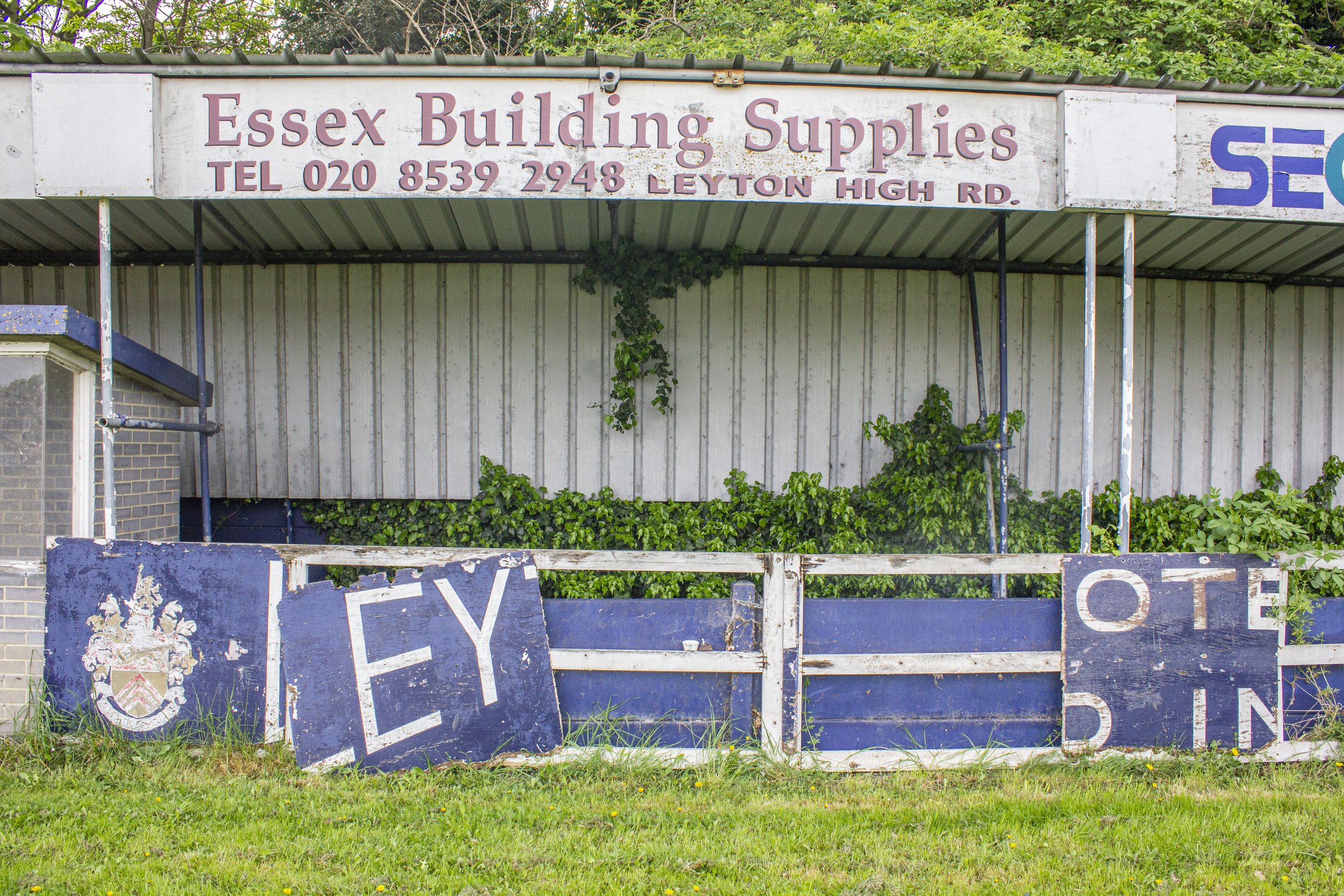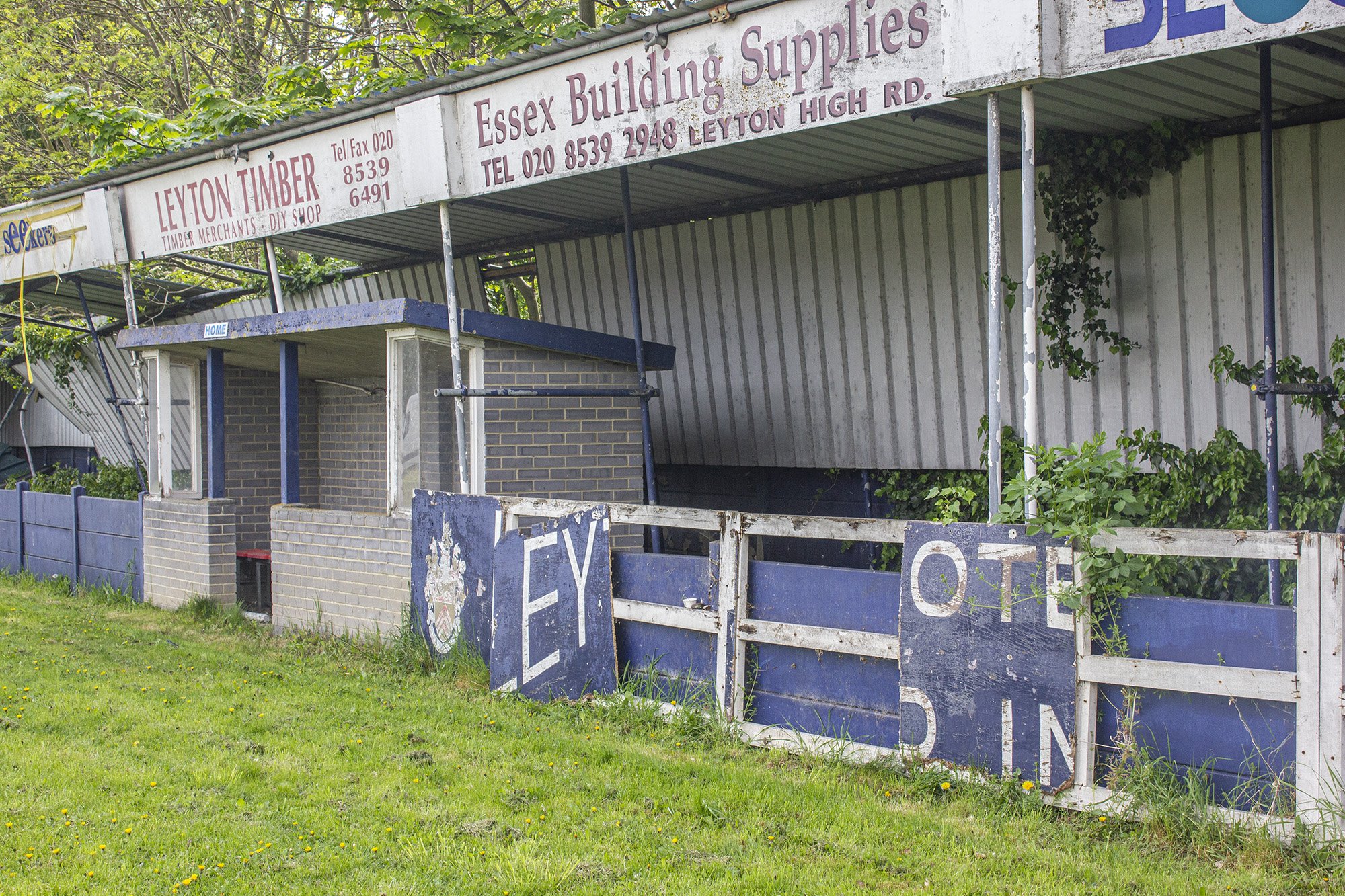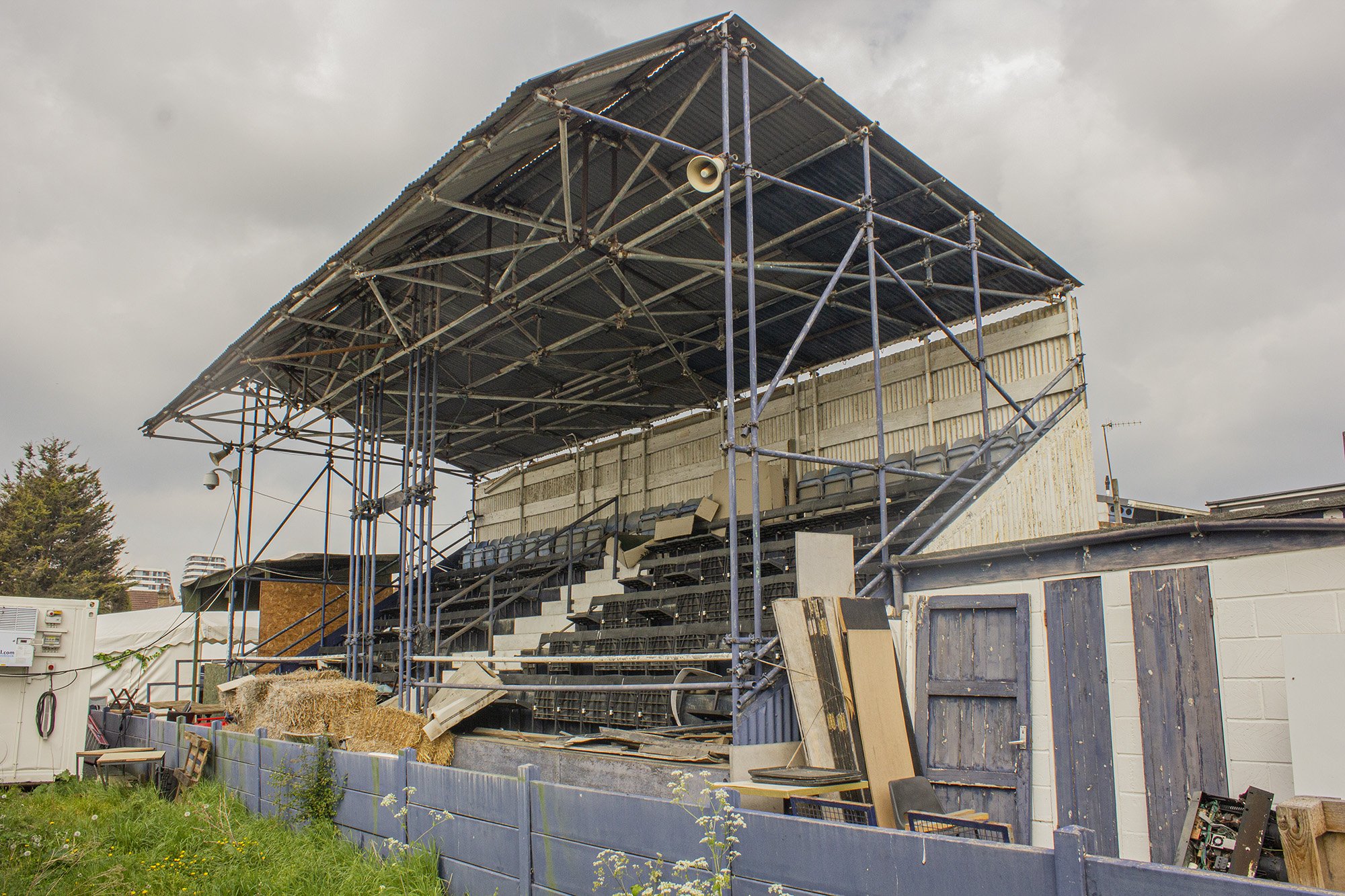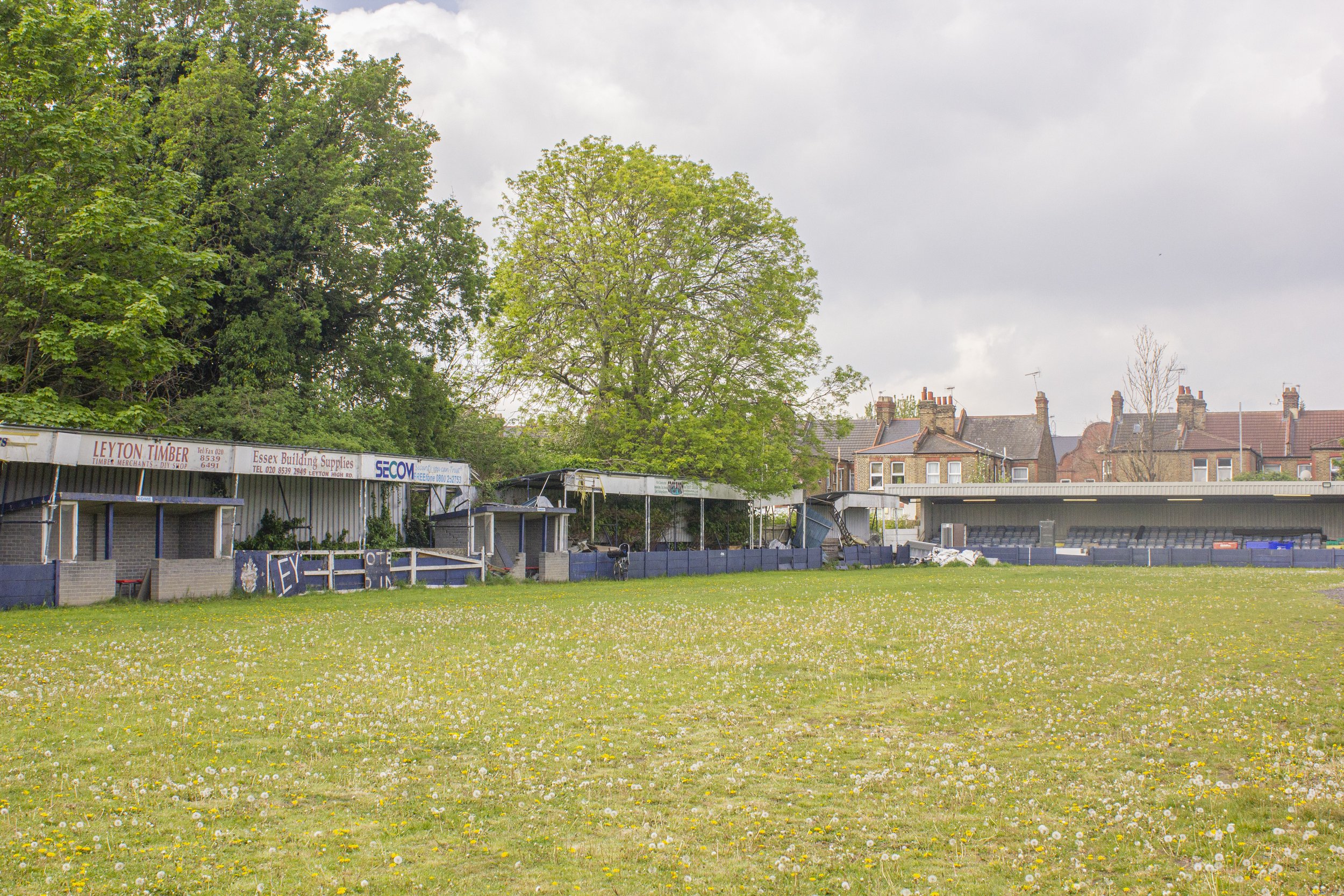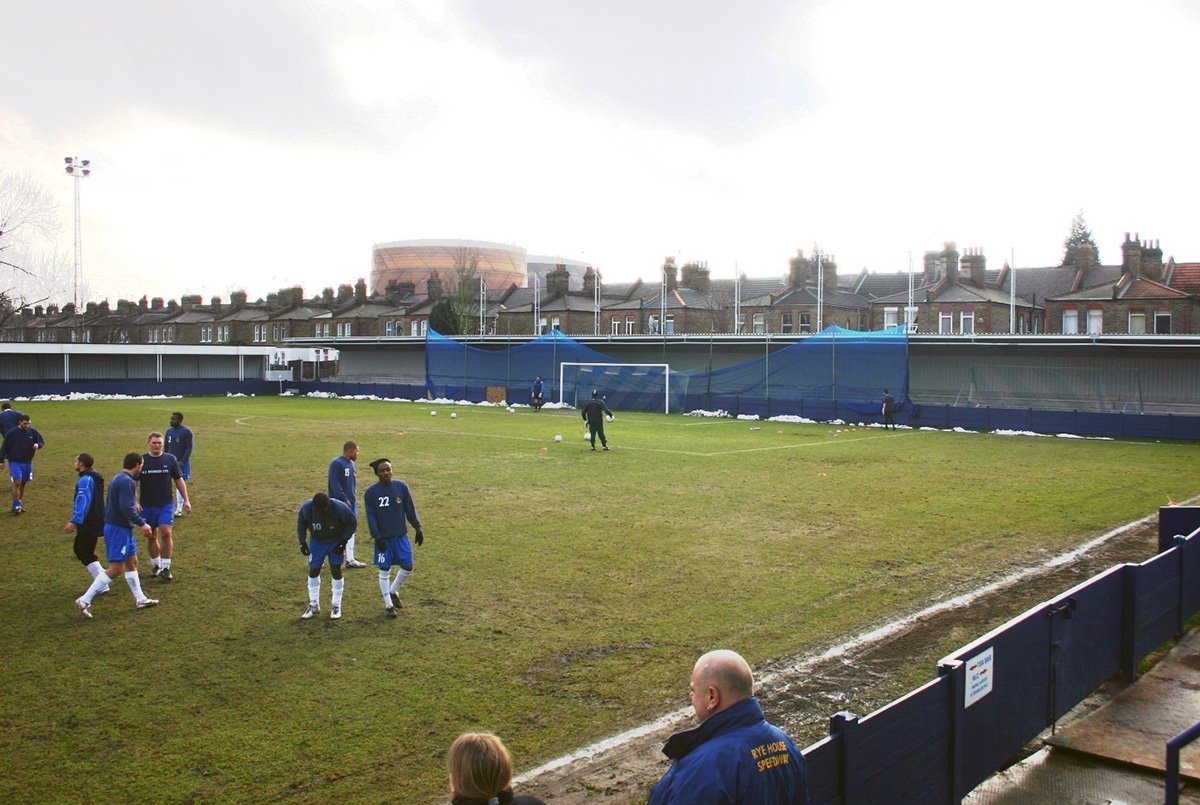For 130 years – from their formation in 1881 to 2011 – Leyton Orient were not the only team in Leyton. Just a 20-minute walk from their Brisbane Road ground, up Oliver Road and Church Road, lay the 4,000-capacity home of their E10 neighbours: Leyton FC.
Despite being abandoned well over a decade ago, it’s still there. Sure, the terraces are rapidly being colonised by Japanese knotweed, and the west stand has become a fridge graveyard, but the Leyton Stadium – previously known as the Hare & Hounds, after the pub next to it – remains intact. And amazingly, you can stroll straight inside.
You think, upon wandering in, of the stories this old venue must have. Of the trivia linked to it. Did you know, for example, that this is where Harry Kane discovered the beautiful game? And where the future manager of a Spanish giant spent a solitary season?
Leyton FC’s bonkers story begins with the Reverend Morgan Lloyd who, in 1868, acquired a pitch behind The Lion & Key (not to be confused with the Hare & Hounds) – with the aim of establishing E10’s first football club.
And not just E10’s, but east London’s. North London’s too, in fact. Only south-east London’s Cray Wanderers – formed in 1860, three years after the rules of football were codified – are older. Leyton FC are 13 years older than Orient, 14 years older than Spurs, and 27 years older than West Ham.
Or, at least, they were. In January 2011 the club – which never climbed higher than the regional, seventh-tier Isthmian League, despite being one game away from promotion to the Conference South in 2004-05 – brought the curtain down on 143 years of existence.
At least, that’s how it appears on paper. The truth is that it’s not just Leyton’s old ground that still exists; it’s the actual club, too. You just need to know where to look.
A little digging quickly reveals that the club who disappeared in 2011 weren’t, by any stretch, the same Leyton founded in 1868. That original incarnation, which aside from some FA Cup forays only played friendlies, folded in 1880 when they lost their Lion & Key pitch.
In 1897-98, a newly formed Leyton FC 2.0 – who played at a recreation ground off James Lane – joined an actual league: London League Division One. Rather than being the impetus for the club to kick on and progress, it effectively sparked almost three decades of drama that saw them leave and rejoin the London League, leave again, join the Southern League and then the Western League, then leave the Southern League to join the South Essex League. Did they even remember they had a Western League team? Who knows. One thing is for certain, though: in 1926-27, Leyton won the FA Amateur Cup after beating Barking Town 3-1 at The Den. The glory years had begun.
But I’m getting ahead of myself. Let’s unpack some of the aforementioned drama, starting with the 1898-99 campaign. Forward Billy Barnes, who joined Leyton after spells with Thames Ironworks (soon to become West Ham United) and South West Ham (who later dissolved after realising their name was literally all over the place), helped the club finish second after netting eight times from 28 appearances.
That respectable return earned him a move to Sheffield United, for whom Billy only went and scored the winning goal in the 1902 FA Cup Final. He later turned out for West Ham (becoming one of the few players to represent the Hammers and Thames Ironworks), Luton and QPR. And then, just when a glorious coaching career beckoned, the First World War started.
Rather than join the army, however, Billy hopped aboard a ship to the Basque Country and, thanks to his connections and playing pedigree, secured a plum position as manager of Athletic Bilbao. Billy won successive Copa del Reys in his first two seasons with Los Leones – defeating Espanyol 2-1 in 1915 and Real Madrid 4-0 a year later. Not bad for a Leyton one-season wonder, eh?
Athletic Bilbao line up against España FC in the 1914 Copa del Rey final, shortly before Billy Barnes took over
While Billy was scoring FA Cup-winning goals and defeating European giants, things back at the club he left behind were a little more up and down. Leyton FC 2.0, who moved to the Hare & Hounds and turned professional around the turn of the century, had started attracting crowds of 5,000. After four seasons, it became clear that somewhere bigger was needed to accommodate them.
In 1905, they decided more space could be had at Osborne Road – a ground that would later be known as Brisbane Road, and which to this day remains the home of Leyton Orient. Things there ticked along nicely until 1912, when a dastardly donor decided he needed his loan back. Leyton FC 2.0 – who a few months earlier had narrowly lost 1-0 at home to Liverpool in the first round of the FA Cup – couldn’t pay it, and that was that.
If there was one word that characterised the Lilywhites (the club’s nickname, in case that wasn’t obvious) though, it was resilience. In 1913, a group of eternal optimists got together and founded Leyton FC 3.0 back at the Hare & Hounds, blissfully unaware – or maybe in denial – that the war that threatened to end Billy Barnes’ coaching career before it started could also end the club, which of course it sadly did.
But, like a phoenix rising from the flames, Leyton FC 4.0 were founded in 1919. They remained at the Hare & Hounds until 1922, at which point they set off on a grand 20-year tour of nearby stadia: starting with Leyton Cricket Ground, then back to Osborne Road for eight years or so, then up to Green Pond Road in Walthamstow, then Lea Bridge Speedway, then Osborne Road for three more years, then West Ham’s Boleyn Ground, then finally back to the Hare & Hounds permanently at the end of the Second World War. Phew.
Newspaper coverage of Leyton’s move to Lea Bridge Speedway in 1938. Published with permission from Vince Taylor
Now, Leyton FC 4.0 were a decent team. After their FA Amateur Cup triumph in 1927, the Lilywhites left the geographically limited South Essex League to join the slightly less geographically limited Athenian League. Covering London and the south-east, the competition initially competed with, and then became a de facto feeder to, the Isthmian League – where, decades later, the club would meet their sad demise.
Leyton finished their first season at this level in fourth place, just eight points behind title winners Sutton United. What was more impressive, though, was their FA Amateur Cup defence. After beating Wimbledon 3-0 away from home in round three, Leyton were handed an intriguing quarter-final tie at home against neighbours Leytonstone.
Despite their proximity, there wasn’t an intense rivalry between the teams from E10 and E11. Leytonstone had been in the Isthmian League, and therefore separated from Leyton, since 1908. And, while Leytonstone had enjoyed a relatively drama-free existence since their formation, Leyton had dealt with existential crisis after existential crisis. A rivalry never had the chance to emerge.
Leyton ended up trouncing Leytonstone 3-0 at Osborne Road – a result that spurred the Lilywhites to a 5-2 semi-final victory over Cambridge Town (now, of course, Cambridge City). The reward? A trip to Middlesbrough’s Ayresome Park for a second successive final. Their opponents? The mighty Cockfield FC, also known as the ‘village wonder team’. They weren’t clucking good enough to beat Leyton, though, who retained their crown after a frenetic 3-2 victory. They’d had a field day. They were cock-a-hoop. Etc, etc.
Leyton’s programme template in 1935-36. Published with permission from Vince Taylor
Leyton somehow reached the final again in 1928-29 (a season that saw them win the Athenian League), only to lose to Ilford from down the road. But, by this stage of their history, a long-awaited culture of success and stability had set in. Between the mid 1920s and the outbreak of the Second World War, the Lilywhites reached the second round of the FA Cup twice, regularly challenged for Athenian League titles, and reached two more FA Amateur Cup finals.
Sure, the war got in the way in a bit, but when football returned in 1945-46 Leyton FC 4.0 – now back in their rightful home – pretty much picked up where they left off. A runners-up spot was an encouraging return after six seasons away from the Athenian League, but then… well, things went a bit stagnant for a couple of decades, truth be told. Leyton finished bottom quite a few times, without ever suffering the real indignity of relegation.
In 1963, the Athenian League realised that a lack of promotion and relegation was getting a bit boring. So, to spice things up a bit, it expanded to three divisions: the Premier Division, Division One and Division Two. Leyton squeezed into the Premier and, realising they too needed to spice things up, went and won it in both 1965-66 and 1966-67.
Perhaps the second title win can be partly attributed to a desire to outdo their E11 neighbours who, in 1965-66, won the ever-so-slightly-more-challenging Isthmian League. When Leytonstone brought home Leyton’s favourite trophy, the FA Amateur Cup, two years later, they secured a place in the two-legged final of the Coppa Ottorino Barassi – the Italian-English Amateur League Cup.
This was semi-significant for Leyton because the first leg was played at the Leyton Stadium, the new name for the Hare & Hounds. Which isn’t true at all, because some wind-up merchant also decided to call Osborne Road the Leyton Stadium in the mid-to-late 60s – and it was here that Leytonstone’s glamour tie against S.T.E.F.E.R. Rome, the reigning Italian Amateur Cup Champions, was actually played on 27 September 1968.
It was a fascinating encounter that deserves its own paragraph (mainly because I’d written it before discovering that there was another Leyton Stadium, ahem). After a cagey 1-1 draw, all eyes were on the rather more opulent Stadio Olimpico for the second leg on 12 October. It finished 2-2; Leytonstone winning on away goals.
While their neighbours were triumphing in Europe, things started going almost spectacularly badly for Leyton. Their 1967-68 Athenian Premier Division title defence ended in relegation to Division One. Twelve months later, they were relegated again to Division Two. There they languished for five seasons, only escaping in 1974-75. The damage, however, had been done. Leyton FC 4.0 were too weak continue. To ensure some kind of survival, they merged with former Division Two rivals Wingate to become – you guessed it – Leyton Wingate.
It was a strange merger on the face of it. Wingate (named after Orde Wingate, the maverick major general who I’ve written about here) were based in Hendon, which – and I don’t care how much you value the North Circular – is definitely not near Leyton. But then, these were clubs in crisis. Leyton no longer had the resources to carry on; Wingate, thanks to the new M1 motorway bulldozing its way through their Hall Lane ground, no longer had a home.
After an awkward getting-to-know-each-other season, the merger soon bore football-shaped fruit. In 1975-76, Leyton Wingate won Division One of the Athenian League to make a return, of sorts, to the Premier Division. In 1981-82, they won it after going an entire season unbeaten. Played 36. Won 28. Drew eight. Lost zero. Goal difference 68. Have some of that.
It was time for a new challenge. The club applied to join the Isthmian League, which had an identical structure to the Athenian League. They’d have to start in Division Two, but that’d be fine. After their exploits the previous season, the league’s committee couldn’t really say no, could they?
So, 1982-83 marked the start of Leyton Wingate’s Isthmian adventure – the likes of Banstead Athletic and Woodford Town replaced by Corinthian Casuals and Windsor & Eton. So too did it mark the start of a race to catch up with Leytonstone (now Leytonstone Ilford after their own merger in 1979), who were sitting pretty in the Premier Division.
That race got off to an encouraging start: after successive fourth and third-placed finishes, Leyton Wingate were promoted to Isthmian League Division One in 1984-85 – the same season that Leytonstone Ilford were relegated from the Premier. In 1985-86 – approximately a century since their respective formations – the clubs would finally compete in the same league.
It had taken just three years for Leyton to catch up with Leytonstone, and the Lilywhites were in no mood to slow down. Their first season at this level resulted in a points haul of 73 (and a seven-game run to the first round of the FA Cup to boot) – just seven off title-winners St Albans City, and enough to earn them sixth place. Leytonstone Ilford, meanwhile, languished down in 12th – one of their lowest-ever finishes. Had the tables turned?
Published with permission from Vince Taylor
Well, my goodness me, we’d certainly find out in 1986-87 – when Leytonstone Ilford decided they’d had quite enough of their noisy neighbours (though this wasn’t why they moved from Granleigh Road to Walthamstow Avenue’s Green Pond Road in the close season). And if they bloody well went for it, then so did Leyton Wingate – who were clearly relishing their upstart status. If there wasn’t a rivalry before, there certainly was now.
On 29 October 1986, Leyton Wingate made the hop, skip and jump down Markhouse Road to casually hammer their neighbours 5-1. It set in motion a toe-to-toe title race that partly culminated in the return fixture at the Leyton Stadium on 18 March 1987. By this point, Leytonstone Ilford were well and truly on one. They edged their neighbours 2-1 and went on to win the Division One title, finishing 13 points ahead of second-placed Leyton Wingate. Both teams, though, were promoted to the Premier. The derby would return.
The downside to their shared glory, however, was that there was barely anyone there to bask in it. Both clubs attracted crowds of only 150 to 200 people. Their rivalry had emerged at the worst possible time; during the mid 80s, fewer people than ever were turning up to watch football matches in England. And, for a lot of clubs, low crowds were simply not sustainable.
Leyton Wingate remained in the Isthmian Premier, rubbing shoulders with the likes of Yeovil Town and Dulwich Hamlet, for four unremarkable seasons. Just one top-half finish was achieved before the Lilywhites fell through the basement door at the end of the 1990-91 season – which, incidentally, was won by Redbridge Forest.
Published with permission from Vince Taylor
Now, Redbridge Forest, whose reward was promotion to the Conference, weren’t historically Redbridge Forest. Two seasons previously, they were officially known as ‘Leytonstone Ilford incorporating Walthamstow Avenue’, after Leytonstone Ilford swallowed up the team they groundshared with. The catchily named outfit won the Isthmian Premier in 1988-89, but were denied promotion owing to the sorry state of Green Pond Road. So, to achieve their ambitions of fifth-tier football, they renamed themselves Redbridge Forest and moved to Dagenham. That marked the end of Leytonstone FC in any recognisable form, and the end of the Leyton/Leytonstone derby. Boo.
Leyton Wingate plodded on for one season in Division One before deciding on a drastic change. There was a new kid on the block over in north London, and they were called Wingate & Finchley. They asked Leyton Wingate to consider dropping ‘Wingate’ and, when the club realised that their original Wingate contingent had either passed away or moved away, they duly obliged. Leyton FC 6.0 were born.
After three more solid but unspectacular seasons in Division One, the Lilywhites’ priorities shifted to the state of the Leyton Stadium. By 1994-95, it was looking a bit shabby and – with no means of funding much-needed improvements – the club decided to merge with Isthmian League door-knockers Walthamstow Pennant. The decision meant abandoning the Hare & Hounds and moving into Pennant’s Wadham Lodge ground in E17.
Leyton Pennant continued Leyton FC 6.0’s bang-averageness in Isthmian League Division One until they were eventually relegated to Division Two in 1999-00. A couple of interesting things happened before then, though. In the summer of 1996, Leyton Stadium’s clubhouse, which appears to have remained open, screened England’s Euro 96 games on a big ol’ TV. Amongst the crowd was a toddler-sized Harry Kane. This, apparently, is where his relationship with football began.
The clubhouse. Published with permission from Vince Taylor
A year later, Leyton FC 8.0 arrived – pretty much out of nowhere, and entirely of their own accord. Bankrolled by local businessman Costas Sophocleous (previously a very successful Leyton youth team manager), they were partly founded out of frustration that Leyton Pennant had become a Walthamstow team. When Sophocleous got the keys to the Hare & Hounds, I think (though I may be completely wrong) he initially focused on turning the clubhouse into the E10 entertainment venue – hence those Euro 96 screenings. This also gave him a bit of space to plot – a word I don’t use lightly – how his new team would achieve success.
In 1997-98, Leyton FC 8.0 began their maiden season in Division One South of the Spartan South Midlands League (no, me neither). A year later, they joined the Essex Intermediate League. Then, in the season Leyton Pennant went down, they joined the Essex Senior League. Here they stayed until 2001-02, when they won the title – and with it, promotion to Division Two of the Isthmian League. S**t was about to get real.
Leyton Pennant – a.k.a. Leyton FC 7.0 – played the 2002-03 season in Division One North of the Isthmian League, just one level above Leyton FC 8.0. It was a crazy situation: two Leyton FC’s playing in the same league structure. And, with both claiming to be the ‘real’ Leyton FC, something had to give. That thing ended up being Leyton Pennant’s name, which in 2003 became Waltham Forest, after the London borough that contains Leyton and Walthamstow.
The club, which subsequently received a hefty cash injection and made public their ambition to reach the Football League, ended up spending most of the next decade in Division One North before changing their name again – this time to Walthamstow – in 2018. In 2021-22, Walthamstow FC – a proper community club with a brilliant fanbase – stormed to the Essex Senior League title. Up the Stow!
Published with permission from Vince Taylor
Now, there’s more to Leyton Pennant’s name change than I’ve let on. In 2002, Leyton FC 8.0 and their expensive Sophocleous-funded lawyers took Leyton Pennant to the High Court. They wanted to be legally recognised as the original, restored Leyton FC – inclusive of their FA membership and history all the way back to 1868 – and for Leyton Pennant to remove any claim of association to Leyton FC. They won and, well, it was a tad controversial.
Put yourself in the shoes of a loyal Leyton FC fan. You had followed the club through thick and thin; perhaps bemoaned their move to Walthamstow, but carried on supporting the lads nonetheless. Were you supposed to switch allegiances to a team of players you had no affinity with, and who now owned all your club’s achievements?
I’m not saying this was the consensus view. Perhaps the relocation was too much for some Leyton fans; if it was, they no doubt welcomed a Leyton team returning to their historical home. But, two decades after the High Court case, some supporters are still talking about Leyton FC 8.0 essentially buying Leyton FC 7.0’s history. Clearly, Sophocleous’ Leyton were no fans’ phoenix club.
Leyton FC 8.0 were promoted to Isthmian League Division One North in 2002-03 – where, of course, the newly named Waltham Forest lay in wait. Leyton did the double over their previous incarnation, beating them 1-0 at the Hare & Hounds and 2-1 at Wadham Lodge, en route to a second-place finish and promotion to the Isthmian Premier for the first time in their incredibly short (or, for legal reasons: incredibly long) history.
Published with permission from Vince Taylor
Leyton had achieved three successive promotions, but they weren’t stopping there. Strikers Leli Bajada and Manny Williams scored 22 and 18 goals respectively in 2004-05 as Stuart Hibberd’s Lilywhites challenged for the Isthmian Premier play-off places. Impressive wins over Salisbury City, Chelmsford City and Kingstonian ensured a fifth-place finish – enough for them to sneak into the play-offs on goal difference.
Their reward was a one-legged semi-final away at league runners-up Billericay Town, who were massive favourites to go up. No bother, though – Leyton, with their close-knit squad, comfortably saw off their higher-profile opponents 2-0. The victory set up an equally daunting play-off final at Eastleigh, whose higher league placing meant they’d have home advantage.
If Leyton were going up to the Conference South, they’d have to do it the hard way. So, on 7 May 2005, they headed to Hampshire in search of glory. Almost 1,000 spectators were inside Eastleigh’s Ten Acres ground that day, and they were in for quite a treat. After 14 minutes, defender Ryan Ashford put the home side ahead. Ten minutes later, however, Manny Williams got the last touch in a goalmouth scramble to equalise for the Londoners.
After that, it was all Leyton. Eastleigh goalkeeper Wayne Shaw pulled off save after save – one from a Williams overhead kick – to keep the Spitfires in it. Half time arrived. Eastleigh regrouped. They emerged in the second half looking tighter and more organised. And then, on 68 minutes, they found their way through. Ashford swung in an inch-perfect cross for the ponytailed Paul Sales to head home. It was 2-1 to the home side.
Published with permission from Vince Taylor
Things went from bad to worse for Leyton when their captain, Scott Curley, received two yellow cards in quick succession. Despite being a man down, however, they started piling on the pressure. Three clear-cut chances ended with three more excellent Shaw saves and Eastleigh, their heels firmly dug into the tired Ten Acres pitch, successfully saw the game out. The Lilywhites had pushed them all the way, but they’d have to settle for another season in the Isthmian Premier.
Leyton FC 8.0 never could match their achievements of 2004-05. After successive 15th-placed finishes, and some bumper crowds when AFC Wimbledon rolled into town, they were relegated back to Division One North in 2007-08 – conceding 123 goals along the way – before disappearing altogether in 2010-11. What on earth happened?
Well, the wheels began falling off in 2009, when Sophocleous – now chairman and bankroller after being manager and bankroller a few years before – pleaded guilty to his central role in an extraordinary VAT scam. He and two others had fraudulently claimed millions of pounds in VAT rebates for the cost of homes that were never going to be built. In January 2010, he was jailed for eight years and six months.
Leyton did manage to complete the 2009-10 season – finishing 20th in Division One North – but this was clearly a club in crisis. Board member Barry Abbott said after Sophocleous’ sentencing that “there are no problems with the club” and that “we have moved on from what has happened” but, with crowd numbers plummeting and no other money coming in, they were on borrowed time.
Published with permission from Vince Taylor
Not long after the 2010-11 season kicked off, Leyton were handed a short suspension from the Isthmian League after failing to pay the first instalment of their annual subscription fee. When they were allowed to play, there was no guarantee of matches going ahead. The state of the Hare & Hounds – dangerous seats, failing floodlights – saw quite a few postponed. Their home game against Ilford on 20 November 2010, which they lost 3-0, attracted just 23 people – which, if you include the referee, was also the number of people on the pitch. It was to be the last match Leyton FC ever played.
On 12 January 2011, the Isthmian League announced that Leyton would be subject to a further suspension after failing to pay the second instalment of their subscription fee. Two days later, a further statement was released. Leyton FC, it said, had given “immediate notice of their withdrawal” from the competition.
Chairman Tony Hardy and club secretary Steve Bellanoff, who had put their own money – and many, many hours – into the club in an honourable attempt to keep it afloat, very reluctantly made for the exit door. The players and management team then tried to work out how to save Leyton, but when they learned just how big the club’s debts were, they had no real choice but to depart too. When they did, Leyton FC’s 143-year existence technically ended.
The Leyton Stadium, though, was never torn down. It never did become a supermarket, nor a housing development. Two years after it was abandoned, the Saffron Kitchen – a very nice Indian restaurant, by all accounts – took over the clubhouse. A section of the pitch became a place to accommodate large private parties in marquees. Another section became an overflow carpark. The stands were handy for temporarily storing old cooking appliances.
In 2015, the London Borough of Waltham Forest designated the ground an Asset of Community Value (ACV) – which essentially gave the local community a say in how the site would be used (and, if they were able to get together enough money, the right to buy it themselves).
In December 2021, however, the council decided not to renew the ACV status. “There is no possibility”, it grimly concluded, “that the space might be used in the future for any purpose that would allow the property to be described as furthering social wellbeing or community space”. In addition, it was de-designated as a sports pitch.
Soon, the Leyton Stadium – its half-collapsed roofs, crumbling terraces and strangely still-functional strip lighting – will almost certainly be turned into 100 homes and a health centre, if an application for its redevelopment gets the green light. (Interestingly, this application highlighted that the site has a covenant for sports. You would think, then, that some kind of pitch – albeit probably a small one – will be factored into the plans.)
If I were you, I’d go and see it while you still can. And, when you’ve done that, check out when Walthamstow (you know, the continuation of the original Leyton FC) are next playing and get yourself to Wadham Lodge.
Despite its likely redevelopment, there is a campaign to bring football back to the Leyton Stadium. You can follow its progress – and sign its petition – here.
I wouldn’t have been able to write this article without the Football Club History Database Index and the Isthmian League Archive. Both are fantastic resources that should be protected and treasured forever. Big up The Ball is Square, too.
Heartfelt thanks, also, to Andrzej Perkins, Walthamstow FC’s communications manager, David Chapman, the club’s historian, and Vince Taylor, co-editor of Groundtastic.
Got this far and want more? Check out my post on Leytonstone FC, which covers that time they played Nigeria in a friendly, their lost Granleigh Road ground, and where they can (kind of, in a way) be found today.
Still want more? Keep scrolling for more images from my visit to the Leyton Stadium in April 2022.
